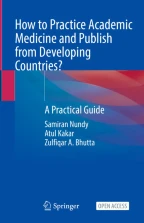
An Editorial is defined as an opinion or a view of a member of the editorial board or any senior or reputed faculty written in a journal or newspaper. The statement reflects the opinion of the journal and is considered to be an option maker. If you have been asked to write an editorial it means that you are an expert on that topic. Editorials are generally solicited.
Editorial writers enter after battle and shoot the wounded
Neil Goldschmidt, American Businessman and Politician (1940–…)
You have full access to this open access chapter, Download chapter PDF
An Editorial is defined as an opinion or a view of a member of the editorial board or any senior or reputed faculty written in a journal or newspaper. The statement reflects the opinion of the journal and is considered to be an option maker. If you have been asked to write an editorial it means that you are an expert on that topic. Editorials are generally solicited.
This is decided by the members of the editorial board and is usually related to important work which is about to be published in the journal. If you are invited to write an editorial on a topic of your choosing you should preferably write one on a general or public health problem that might interest a wide readership [1].
It has been said that ‘Editors, by and large, are reticent people, with a magnified sense of their own importance. Well, this may hurt some, but before they jump at our throats, let us clarify that we belong there as well’. The editorial should not look like an introduction to an original article or a self-glorifying piece of fiction.
Editorial writing has been compared to a double-edged sword, you can be apolitical and pragmatic but at the same time dogmatic in your views. The majority of editorials provide the readers a balanced view of the problems raised in a particular research paper and place them in a wider context. But there is no harm in going to extremes if the data supports your view. However, you should not mock the paper’s authors [2].
First, read the paper for which the editorial has been asked again and again. Do a literature search and critically analyze the strengths and weaknesses of the study. Read about how and why other authors came to similar or different conclusions. Discuss whether or not the findings are important [3].
An editorial should be brief, about one to two pages long, but it should be powerful. The language should be a combination of good English and good science. The writing can be ‘embellished by language but not drowned in it’. While a good editorial states a view, it does not force the reader to believe it and gives him the liberty to form his own opinion.
Editorials can be classified into four types. They may:
An editorial is a personal message from the editor to the readers. It may be a commentary on a published article or topic of current interest which has not been covered by the journal. Editorials are also written on new developments in medicine. They may also cover non-scientific topics like health policy, law and medicine, violence against doctors, climate change and its effect on health, re-emerging infectious diseases, public interventions for the control of non -communicable diseases and ongoing epidemics or pandemics [4].
Many editorials written by in-house editors or their teams represent the voice of the journal. A few journals allow outside authors to write editorials. The details for these suggested by some of the leading journals are given in Table 26.1.
Table 26.1 Details about EditorialA Viewpoint is a short article that focuses on some key issues, cutting-edge technology or burning topics or any new developments in the field of medicine. It can be a ‘personal opinion’ or any piece of information, which gives the author’s perspective on a particular issue, supported by the literature. Viewpoints can also be unencumbered by journal policy. The normal length of viewpoints can flexible. The BMJ, for instance, also allows viewpoints to be written by patients.
Viewpoints may share a few common features with commentaries, perspectives and a focus which is a brief, timely piece of information. It is like a ‘spotlight’ that contains information on research funding, policy issues and regulatory issues whereas a commentary is an in-depth analysis of a current matter which can also include educational policy, law besides any other seminal issue.
Open Access This chapter is licensed under the terms of the Creative Commons Attribution 4.0 International License (http://creativecommons.org/licenses/by/4.0/), which permits use, sharing, adaptation, distribution and reproduction in any medium or format, as long as you give appropriate credit to the original author(s) and the source, provide a link to the Creative Commons license and indicate if changes were made.
The images or other third party material in this chapter are included in the chapter's Creative Commons license, unless indicated otherwise in a credit line to the material. If material is not included in the chapter's Creative Commons license and your intended use is not permitted by statutory regulation or exceeds the permitted use, you will need to obtain permission directly from the copyright holder.
© 2022 The Author(s)
Nundy, S., Kakar, A., Bhutta, Z.A. (2022). How to Write an Editorial?. In: How to Practice Academic Medicine and Publish from Developing Countries?. Springer, Singapore. https://doi.org/10.1007/978-981-16-5248-6_26
Anyone you share the following link with will be able to read this content:
Get shareable link
Sorry, a shareable link is not currently available for this article.
Copy to clipboard
Provided by the Springer Nature SharedIt content-sharing initiative